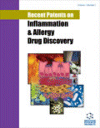Recent Patents on Inflammation & Allergy Drug Discovery - Current Issue
Volume 14, Issue 2, 2020
-
-
Scenario of the Treatment of Arthritis with Natural Products
More LessAuthors: Fernanda C.M. Gallotti, Mairim R. Serafini and Sara M. ThomazziBackground: Conventional treatments of arthritis use toxic and poorly tolerated drugs. Therefore, natural products are an alternative because they are important sources of bioactive substances with therapeutic potential. Objective: To perform synthesis of patent applications associated with the use of natural products in the technological development of the invention for use in treating arthritis. Methods: The search for patents w Read More
-
-
-
Acute Myocarditis in Children: An Overview of Treatment and Recent Patents
More LessAuthors: Ronald C.M. Fung, Kam L. Hon and Alexander K.C. LeungBackground: Pediatric myocarditis is rare but challenging. This overview summarized the current knowledge and recent patents on childhood myocarditis. Methods: Clinical queries and keywords of “myocarditis” and “childhood” were used as search engine. Results: Viral infections are the most common causes of acute myocarditis. Affected children often have a prodrome of fever, malaise, and myalgia. Clinical manifestati Read More
-
-
-
Childhood Alopecia Areata: An Overview of Treatment and Recent Patents
More LessAuthors: Kam L. Hon, David C.K. Luk, Alexander K.C. Leung, Chantel Ng and Steven K.F. LooBackground: Alopecia Areata (AA) is a systemic autoimmune condition that usually starts in childhood. Objective: This article aims to review genetics, therapy, prognosis, and recent patents for AA. Methods: We used clinical queries and keywords “alopecia areata” AND “childhood” as a search engine. Patents were searched using the key term “ alopecia areata” in Patents.google.com and freepatentsonline. com. Results: Read More
-
-
-
Human Ascariasis: An Updated Review
More LessAuthors: Alexander K.C. Leung, Amy A.M. Leung, Alex H.C. Wong and Kam L. HonBackground: Ascaris lumbricoides is the most common helminthic infection. More than 1.2 billion people have ascariasis worldwide. Objective: This article aimed to provide an update on the evaluation, diagnosis, and treatment of ascariasis. Methods: A PubMed search was conducted in February 2020 in Clinical Queries using the key terms “ascariasis” OR “Ascaris lumbricoides”. The search strategy included meta-analyses, rando Read More
-
-
-
Nummular Eczema: An Updated Review
More LessAuthors: Alexander K.C. Leung, Joseph M. Lam, Kin F. Leong, Amy A.M. Leung, Alex H.C. Wong and Kam L. HonBackground: Nummular eczema may mimic diseases that present with annular configuration and the differential diagnosis is broad. Objective: This article aimed to provide an update on the evaluation, diagnosis, and treatment of nummular eczema. Methods: A PubMed search was performed in using the key terms “nummular eczema#8221;, “discoid Methods: A PubMed search was performed in using the key terms “nummular e Read More
-
-
-
Childhood Infectious Encephalitis: An Overview of Clinical Features, Investigations, Treatment, and Recent Patents
More LessAuthors: Cheuk C. Au, Kam L. Hon, Alexander K.C. Leung and Alcy R. TorresBackground: Infectious encephalitis is a serious and challenging condition to manage. This overview summarizes the current literature regarding the etiology, clinical manifestations, diagnosis, management, and recent patents of acute childhood infectious encephalitis. Methods: We used PubMed Clinical Queries as a search engine and used keywords of “encephalitis” AND “childhood” Patents were searched using the key t Read More
-
Most Read This Month Most Read RSS feed
Article
content/journals/iad
Journal
10
5
false
en


